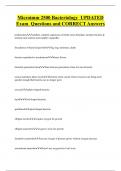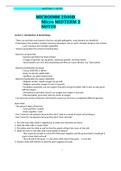Microimm 2500 - Study guides, Class notes & Summaries
Looking for the best study guides, study notes and summaries about Microimm 2500? On this page you'll find 23 study documents about Microimm 2500.
Page 3 out of 23 results
Sort by

-
Microimm 2500 Bacteriology UPDATED Exam Questions and CORRECT Answers
- Exam (elaborations) • 21 pages • 2024
-
- $10.49
- + learn more
prokaryotessmallest, simplest organisms on Earth; most abundant; includes bacteria & archaea; lack nucleus and complex organelles four phases of bacterial growthlag; log; stationary; death bacteria reproductive mechanismbinary fission bacterial generation timetime between generations (time for one division) reason stationary phase existsbacteria reach a point where resources are being used quickly enough that bacteria can no longer grow coccussphere-shaped bacteria

-
Microimm 2500 Virology UPDATED Exam Questions and CORRECT Answers
- Exam (elaborations) • 16 pages • 2024
-
- $10.49
- + learn more
Measlesvirus that is transmitted in aerosols through coughs/sneezes - mostly eradicated in Canada due to vaccination - still present in SA and Africa Endogenous Viral Sequencesviral genetic sequences from infections that occurred that integrate into our own genetic material - no longer infectious Intrinsic Defensesphysical barriers like skin/sweat that keep viruses from entering our body Polydnavirusgene from a virus in wasps that allows eggs to survive in caterpillar larvae by suppr...

-
MICROIMM 2500B Micro MIDTERM 2 NOTES very helpful notes , scored an A midterm
- Summary • 38 pages • 2021
-
- $12.49
- + learn more
MICROIMM 2500B Micro MIDTERM 2 NOTES Lecture 1: Introduction to Bacteriology - There are not that many bacteria that are actually pathogenic; most bacteria are beneficial - Prokaryotes: the smallest, simplest and most abundant cells on earth; includes bacteria and archaea - Lack a nucleus and complex organelles - Viruses outnumber the amount of prokaryotes - Bacteria can grow fast - bacteria reproduce by binary fission - 4 stages of growth: lag, log phase, stationary growth, and th...

That summary you just bought made someone very happy. Also get paid weekly? Sell your study resources on Stuvia! Discover all about earning on Stuvia


